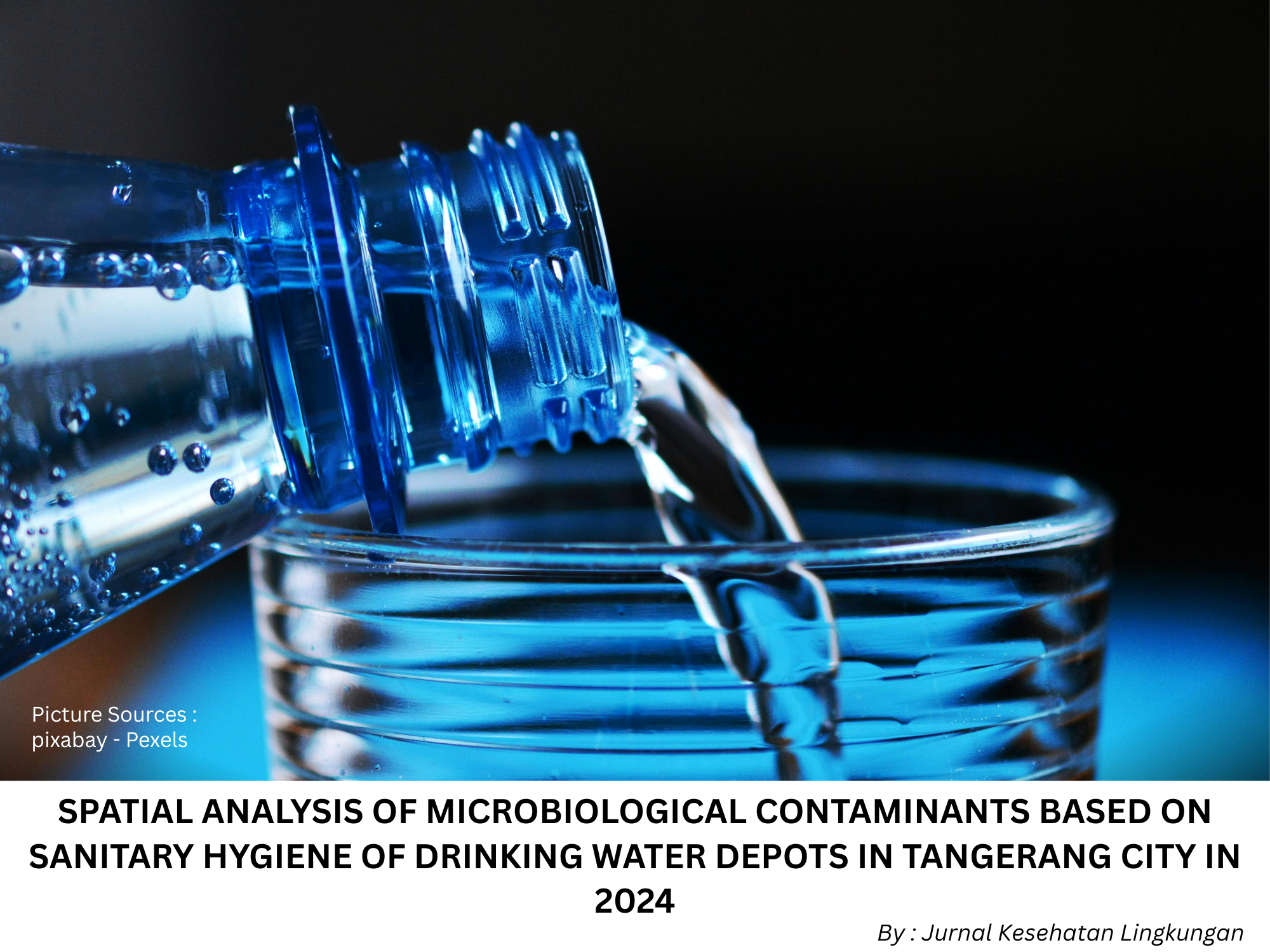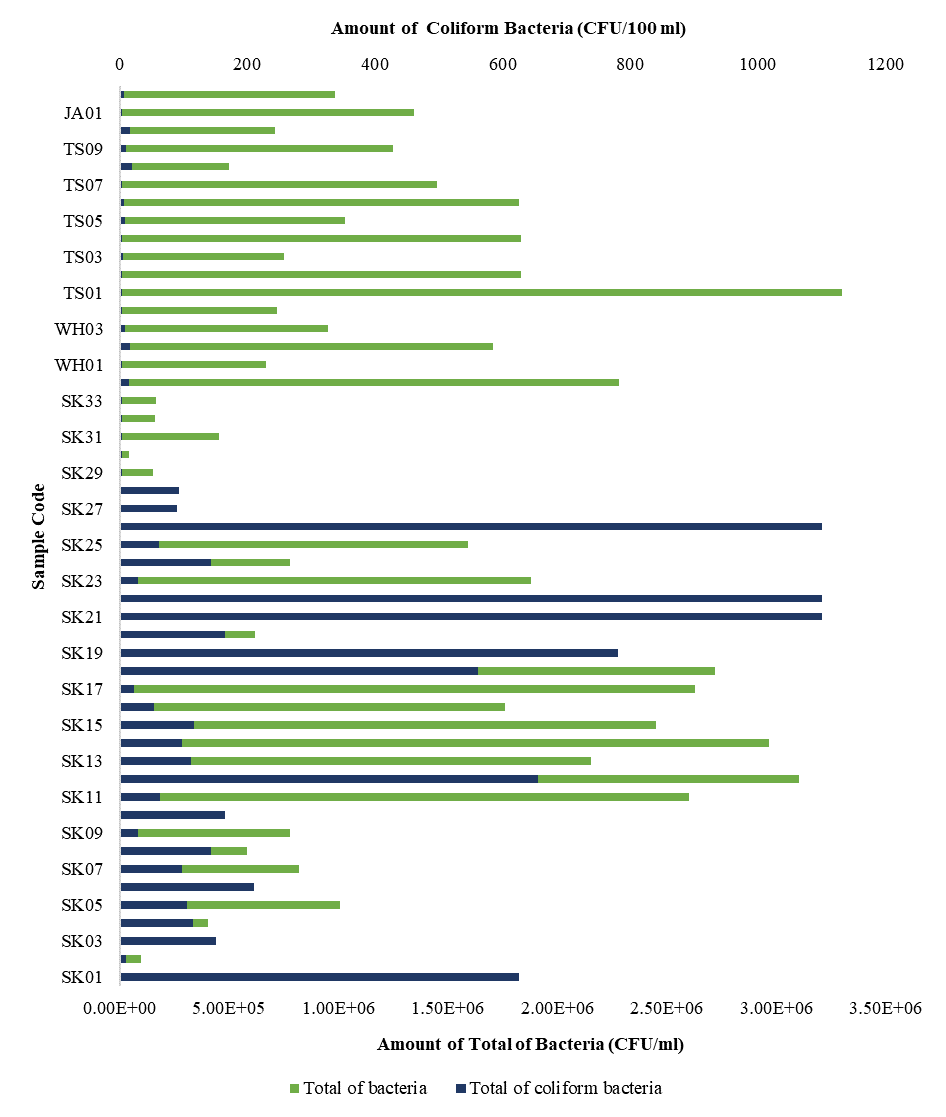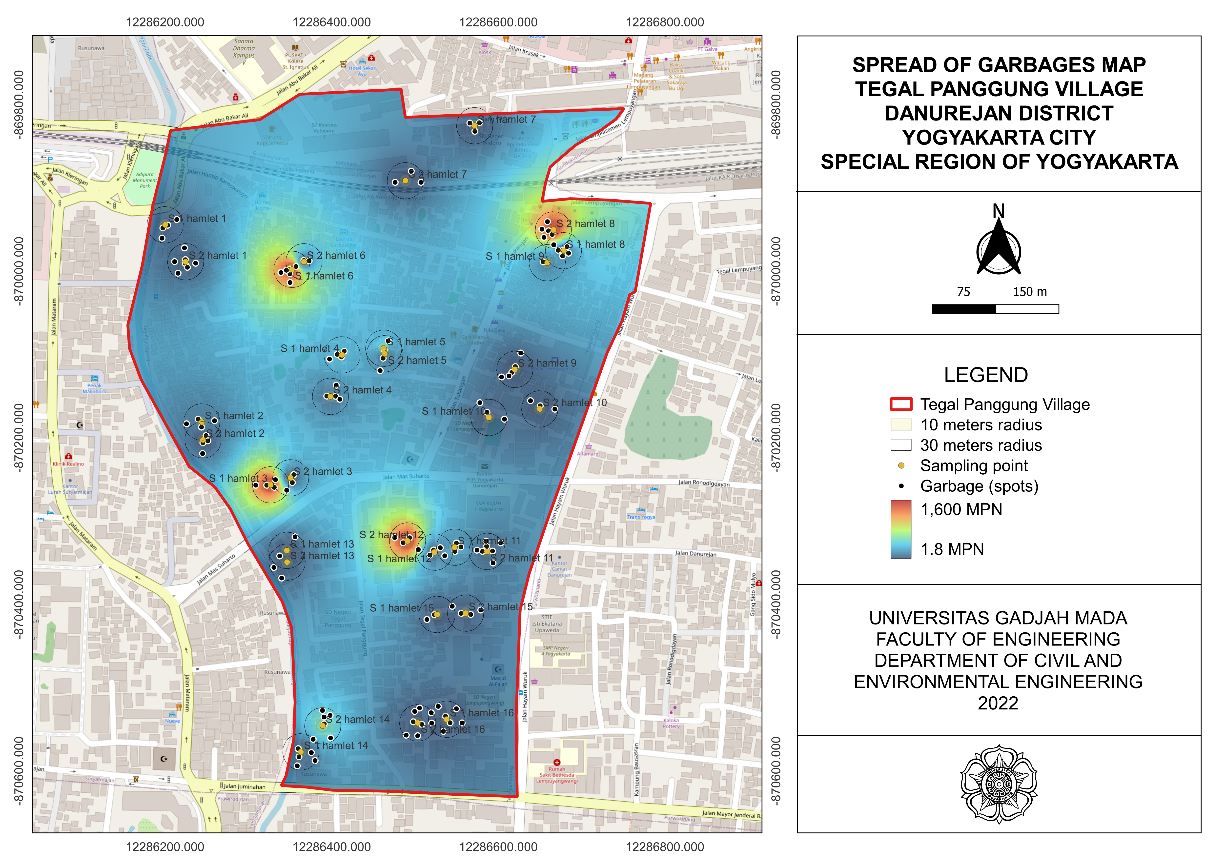Spatial Analysis of Microbiological Contaminants Based on Sanitary Hygiene of Drinking Water Depots in Tangerang City in 2024

Downloads
Introduction: Potable water needs to satisfy quality criteria for microbiological, chemical, and physical. Consuming water that fails to comply with established quality standards can lead to illnesses, including diarrhea. In Tangerang City, based on environment-related disease counseling data from 2024, diarrhea had the highest number of cases. The study examined the influence of DAM sanitary hygiene on the microbiological quality of refilled potable water and to map the distribution of DAM in Tangerang City in 2024. Methods: The study employed a quantitative analytic observation with a cross-sectional method and a secondary data analysis (SDA) with a geographic information system (GIS). Independent variable in this study is the assessment results of the sanitary hygiene DAM and dependent variable is the microbiological quality laboratory test result. The sample consisted of 104 DAM across Tangerang City. Data analysis utilized the Chi-square and binary logistic regression tests. Spatial analysis for thematic map creation was performed using QGIS. Results and Discussion: The results showed that 72.1% of DAM met the sanitary hygiene requirements but 63.5% still had microbiological contaminants. Statistical test results showed that the sanitary hygiene of DAM had a significant partial effect on the microbiological quality of drinking water with a p-value=0.002 (p<0.05). Conclusion: The study concluded that the sanitary hygiene of DAM affects the microbiological quality of drinking water. Other variabels outside the assessment aspects also contribute, such as a contact time of UV light or disinfection equipment, maintenance of filters, and water source quality.
Zandya SLA, Kusumaningtiar DA, Irfandi A, Putri EC. Faktor Predisposisi yang Berhubungan dengan Personal Higiene pada Penjamah Depot Air Minum Isi Ulang (DAMIU) di Desa Mekarsari Tahun 2024. Seroja Husada Jurnal Kesehatan Masyarakat. 2024;1(1):60–9. https://doi.org/10.572349/husada.v1i1.363
Arlinda S, Suksmerri S, Mukhlis M, Mahaza M. Risk Analysis of Community Water Quality in Alahan Panjang Agricultural Area, Solok Regency, West Sumatera, Indonesia. Jurnal Kesehatan Lingkungan. 2022;14(3):193–200.https://doi.org/10.20473/jkl.v14i3.2022.193-200
Badan Pusat Statistik. Statistik Kesejahteraan Rakyat 2024. Jakarta; 2024. 1–516 p. https://www.bps.go.id/id/publication/2024/10/25/30e924add700e5a928c0b26b/statistik-kesejahteraan-rakyat-2024.html
Hafizah S, Harnani Y, Septiani W, Gumayesty Y, Rasyid Z. Analisis Kualitas Air Minum dan Hygiene Sanitasi pada Depot Air Minum Isi Ulang di Wilayah Kelurahan Minas Jaya Tahun 2022. ORKES (Jurnal Olahraga dan Kesehatan). 2022;1(3):740–755. https://doi.org/10.56466/orkes/Vol1.Iss3.52
Siregar N, Tanjung WW, Harahap LJ. Depot Sanitation, Hygiene, and Analysis of Total Microba Control in Refilled Drinking Water in the Barus District. International Journal of Basic and Applied Science. 2022;10(4):154–162. https://doi.org/10.35335/ijobas.v10i4.68
Ndoka FDP, Junias MS, Riwu YR. Gambaran Kualitas Air pada Depot Air Minum Isi Ulang di Kelurahan Tarus. SEHATMAS: Jurnal Ilmiah Kesehatan Masyarakat. 2024;3(2):276–85. https://doi.org/10.55123/sehatmas.v3i2.3429
Pertiwi LA, Siwiendrayanti A. Higiene dan Sanitasi dengan Total Bakteri Coliform pada Depot Air Minum. HIGEIA Journal of Public Health Research and Development. 2024 Aug;7(4):492–502. http://journal.unnes.ac.id/sju/index.php/higeia
Uddin MR, Khandaker MU, Abedin MJ, Akter N, Jamal ASIM, Sultana R, et al. Quality Assessment Of Bottled And Unbottled Drinking Water In Bangladesh. Water (Basel). 2021;13(15):1–20. https://doi.org/10.3390/w13152026
Putri I, Priyono B. Analisis Bakteri Coliform pada Air Minum Isi Ulang di Kecamatan Gajahmungkur. Life Science. 2022;11(1):89–98. http://journal.unnes.ac.id/sju/index.php/LifeSci
Rahayu EP, Herniwanti. Perceptions of Sanitation Hygiene Refill Drinking Water Depot in the Region of Indonesia. Gac Med Caracas. 2022;130(1):225–230. https://doi.org/10.47307/GMC.2022.130.s1.37
Wyasena PNTS, Sudaryati NLG, Sudiartawan IP, Adnyana IMDM. Evaluation of Refillable Drinking Water Quality Based on MPN Coliform and Escherichia Coli in Sesetan Village, South Denpasar, Bali. Journal of Vocational Health Studies. 2022;6(2):93–101. https://doi.org/10.20473/jvhs.V6.I2.2022.93-101
Permenkes RI. Peraturan Menteri Kesehatan RI Nomor 2 Tahun 2023 tentang Peraturan Pelaksanaan Peraturan Pemerintah Nomor 66 Tahun 2014 tentang Kesehatan. Indonesia; 2023. https://peraturan.bpk.go.id/Details/245563/permenkes-no-2-tahun-2023
Rostiana O. Hubungan Sanitasi Tempat, Pemeliharaan Peralatan, dan Hygiene Operator Depot Air Minum Isi Ulang Dengan Kualitas Bakteriologis (Escherichia Coli) di Kecamatan Cempaka Putih Tahun 2021. Dohara Publisher Open Access Journal. 2023;2(06):689–94. https://dohara.or.id/index.php/hsk/article/view/395
Luqman A, Nugrahapraja H, Wahyuono RA, Islami I, Haekal MH, Fardiansyah Y, et al. Microplastic Contamination in Human Stools, Foods, and Drinking Water Associated With Indonesian Coastal Population. Environments - MDPI. 2021;8(12):1-9. https://doi.org/10.3390/environments8120138.
Soryatmodjo D. Pemeriksaan Proses Pengolahan Air Minum Isi Ulang terhadap Jumlah Bakteri dan Pengujian Bakteriologi di Depot Tiban Kota Batam. ABDIRA: Jurnal Pengabdian Masyarakat. 2021;1(2):52–66. https://doi.org/10.31004/abdira.v1i2.36
Alfian AR, Firdani F, Sari PN, Dinata RT. Mengenal Air Minum Isi Ulang. LPPM - Universitas Andalas; 2021. https://www.researchgate.net/publication/372235620_MENGENAL_AIR_MINUM_ISI_ULANG
Badan Pusat Statistik Kota Tangerang. Statistik Daerah Kota Tangerang 2024. Vol. 14. 2024. 1–45 p. https://tangerangkota.bps.go.id/en/publication/2024/09/26/32fae0fab713b4c187de6f27/statistik-daerah-kota-tangerang-2024.html
Aeni HF, Kristanti I, Rohayani Y, Banowati L. The Relationship between Sanitary Hygiene and Coliform Bacteria Contamination at Refill Drinking Water Depots. Consilium Sanitatis: Journal of Health Science and Policy. 2023;1(3):171–187. https://doi.org/10.56855/jhsp.v1i3.612
Azteria V, Rosya E. Drinking Water Quality of Water Refill Station in Gebang Raya Tangerang. Jurnal Kesehatan Lingkungan. 2023;5(2):120–126. https://doi.org/10.20473/jkl.v15i2.2023.120-126
Puspitasari E. Analysis of the Factors Affecting the Quality of the Chemical and Microbiological Drinking Water at the Depot Drinking Water Refill Tulungagung District. Journal for Quality in Public Health. 2018;1(1):104–112. https://doi.org/10.30994/jqph.v1i1.10
Oktaviani T. Higiene dan Sanitasi Depo Air Minum Isi Ulang di PT X, Taman, Sidoarjo. Jurnal Kesehatan Lingkungan. 2018;10(4):376–384. https://doi.org/10.20473/jkl.v10i4.2018.376-384
Peraturan Menteri Kesehatan RI. Peraturan Menteri Kesehatan RI Nomor 14 Tahun 2021 tentang Standar Kegiatan Usaha dan Produk pada Penyelenggaraan Perizinan Berusaha Berbasis Risiko Sektor Kesehatan. Indonesia; 2021. https://peraturan.bpk.go.id/Details/203315/permenkes-no-14-tahun-2021
Agustina AC. Analisis Cemaran Coliform dan Identifikasi Escherichia coli dari Depo Air Minum Isi Ulang di Kota Semarang. Life Science. 2021;10(1):23–32. https://doi.org/10.15294/lifesci.v10i1.47167
Asmadi, Idrus I, Supriyanta B, Iqbah IP, Mulyawati SA, Aryani D, et al. Analisis Kualitas Lingkungan. Eureka Media Aksara. 2023. https://repository.penerbiteureka.com/media/publications/565275-analisis-kualitas-lingkungan-788a59f5.pdf
Atari M, Pramadita S, Sulastri A. Pengaruh Higiene Sanitasi Terhadap Jumlah Bakteri Coliform dalam Air Minum Isi Ulang di Kecamatan Pontianak Kota. JURLIS: Jurnal Rekayasa Lingkungan Tropis Teknik Lingkungan Universitas Tanjungpura. 2021;2(1):1–10. https://ejournal3.undip.ac.id/index.php/jkm/article/download/23011/21050
Rohmah H, Meishanti OPY. E-Coli Bacterial Pollution Test Results in Mineral Water As a Learning Media for Electronic Practicum Instructions. APPLICATION: Applied science in Learning Research. 2021;1(2):42–46. https://doi.org/10.32764/application.v1i1.1652
Toalu A, Alwy SNA, Baharuddin, Nurhartati A. Analisis Kualitas Depot Air Minum Isi Ulang yang Ada di Wilayah Puskesmas Tamalanrea. JIMAD: Jurnal Ilmiah Multidisiplin. 2023;1(1):1–10. https://doi.org/10.59585/jimad.v1i1.154
Novroza HE, Hestiningsih R, Kusariana N, Yuliawati S. Hubungan Higiene Sanitasi Kondisi Depot Air Minum dengan Kualitas Mikrobiologi Air Minum Isi Ulang dii Kecamatan Banyumanik Semarang. Jurnal Kesehatan Masyarakat. 2020;8(2):233–237. Available from: http://ejournal3.undip.ac.id/index.php/jkm
Prasetyo J, Kriswandana F, Darjati. Hubungan Sanitasi Depot Air Minum dengan Kualitas Mikrobiologi Air Minum di Wilayah Kerja Puskesmas Kalirungkut Kota Surabaya. JIMKesmas Jurnal Ilmiah Mahasiswa Kesehatan Masyarakat. 2021;6(1):51–7. https://doi.org/10.37887/jimkesmas.v6i1.16209
Kusumaningrum DA, Sunaryo, Koesmantoro H, Hendrarinata F. Bakteriological Quality of Drinking Water at the Refill Depot of Drinking Water (DAMIU) in the Working Area of the Parang Health Center, Magetan. Jurnal Higiene Sanitasi. 2022;2(2):85–90. https://doi.org/10.36568/hisan.v2i2.29
Adam HAH, Azizah R, Keman S, Leonita A. Analisis Hubungan Sanitasi Tempat dan Alat dengan Keberadaan Bakteri Escherichia Coli Pada Depot Air Minum Isi Ulang (Damiu) di Indonesia: Meta-Analisis Tahun 2011-2021. 2023;16(1):1-12. https://doi.org/10.32763/juke.v16i1
Sari A. Hubungan Higiene Sanitasi dengan Keberadaan Bakteri Escherichia coli pada Depot Air Minum Isi Ulang. Skripsi. Jambi: Universitas Jambi; 2023. https://ejournal.undip.ac.id/index.php/mkmi/article/view/35374
Alfian, Mulasari SA, Santri IN. Hubungan Higiene Petugas Depot Galon dengan Jumlah Bakteri E. coli Air Minum pada Depot Air Minum Isi Ulang. Jurnal Kesehatan dan Pengelolaan Lingkungan. 2021;2(2):146–152. https://doi.org/10.12928/jkpl.v2i2.6349
Zarifah DA, Navianti D, Yulianto Y. Hygiene Sanitasi Depot Air Minum Isi Ulang dan Kualitas Mikrobiologis Air Minum Isi Ulang di Wilayah Kerja Puskesmas Bukitsangkal Kota Palembang. Jurnal Sanitasi Lingkungan. 2022;2(2):85–92. https://doi.org/10.36086/jsl.v2i2.1304
Pou R, Riskawa RM, Marliana R, Rachmayanti B, Rizqy FA, Amiyanti NP. An Overview of Escherichiae coli Contamination in Refill Drinking Water Depot in Pasar Minggu District. Jurnal Penelitian dan Karya Ilmiah Lembaga Penelitian Universitas Trisakti. 2022;8(1):19–29. https://doi.org/10.25105/pdk.v8i1.15080
Jamaluddin, Anasthasia Y. Analisis Standarisasi Depot Air Minum Isi Ulang di Kabupaten Pelalawan Tahun 2021-2022. Jurnal Riset Inovasi Daerah. 2023;1(2):45–54. https://jurnalrivda.pelalawankab.go.id/index.php/rivda/article/download/20/11/177
Wispriyono B, Arsyina L, Ardiansyah I, Pratiwi LD, Arminsih R, Hartono B, et al. The Role of Hygiene and Sanitation to the Escherichia coli Contamination in Drinking Water in Depok City, Indonesia. Open Access Maced J Med Sci. 2021;10;9(9):641–654. https://doi.org/10.3889/oamjms.2021.6152
Arumsari F, Joko T, Darundiati YH. Hubungan Higiene Sanitasi Depot Air Minum dengan Keberadaan Bakteri Escherichia coli pada Air Minum Isi Ulang di Kecamatan Mondokan Kabupaten Sragen. Media Kesehatan Masyarakat Indonesia. 2021;20(2):75–82. https://doi.org/10.14710/mkmi.20.2.75-82
Karjono M, Sintari SNN. Hygine Sanitasi Sangat Penting untuk Mempertahankan Kualitas Air Minum Depo Isi Ulang di Kabupaten Lombok Timur. Jurnal Ilmiah Global Education. 2023;4(2):1116–1121. https://doi.org/10.55681/jige.v4i2.956
Noegraha RA. Reduksi Risiko Kegagalan Kualitas Inlet Produksi Air Minum isi Ulang di Kecamatan Rungkut Surabaya Menggunakan Failure Mode And Effect Analysis (FMEA). Skripsi. Surabaya: Institut Teknologi Sepuluh Nopember; 2025. https://repository.its.ac.id/117220/
Peraturan Menteri Kesehatan RI. Peraturan Menteri Kesehatan Nomor 43 Tahun 2014 tentang Higiene Sanitasi Depot Air Minum. 2014. https://peraturan.bpk.go.id/Details/119084/permenkes-no-43-tahun-2014
Hasanah U, Zanzibar, Suryadinata A. Hubungan Kondisi Fisik dengan Penyediaan Air Minum Terhadap Kualitas Depot Isi Ulang. Indonesian Journal of Health and Medical. 2023;3(4):159–169. http://ijohm.rcipublisher.org/index.php/ijohm

This work is licensed under a Creative Commons Attribution-NonCommercial-ShareAlike 4.0 International License.
1. Copyright of all journal manuscripts is held by the Jurnal Kesehatan Lingkungan.2. Formal legal provisions to access digital articles of electronic journal are subject to the provision of the Creative Commons Attribution-ShareAlike license (CC BY-NC-SA), which means that Jurnal Kesehatan Lingkungan is rightful to keep, transfer media/format, manage in the form of databases, maintain, and publish articles.
3. Published manuscripts both printed and electronic are open access for educational, research, and library purposes. Additionally, the editorial board is not responsible for any violations of copyright law.
JKESLING by UNAIR is licensed under a Creative Commons Attribution-ShareAlike 4.0 International License.







































